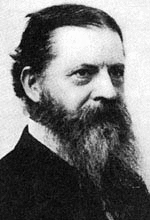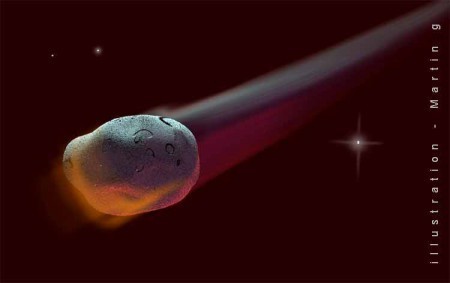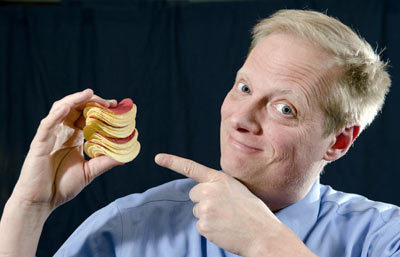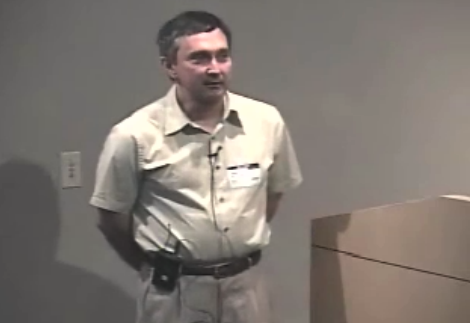Marc Abrahams's Blog, page 573
May 16, 2012
Bushman on Sweets (2): Sugar, Sugar, Sugar, Sugar, Sugar, Sugar, Sugar, Sugar, Sugar
 If you like to read about sugar or about aggressiveness, Brad J. Bushman [pictured here] and colleagues have a study perhaps worth some moments of your time:
If you like to read about sugar or about aggressiveness, Brad J. Bushman [pictured here] and colleagues have a study perhaps worth some moments of your time:
“Sweetened blood cools hot tempers: physiological self-control and aggression,” C. Nathan DeWall, Timothy Deckman, Matthew T. Gailliot, Brad J. Bushman, Aggressive Behavior, 2011 Jan-Feb;37(1):73-80. The authors explain:
“Aggressive and violent behaviors are restrained by self-control. Self-control consumes a lot of glucose in the brain, suggesting that low glucose and poor glucose metabolism are linked to aggression and violence. Four studies tested this hypothesis. Study 1 found that participants who consumed a glucose beverage behaved less aggressively than did participants who consumed a placebo beverage. Study 2 found an indirect relationship between diabetes (a disorder marked by low glucose levels and poor glucose metabolism) and aggressiveness through low self-control. Study 3 found that states with high diabetes rates also had high violent crime rates. Study 4 found that countries with high rates of glucose-6-phosphate dehydrogenase deficiency (a metabolic disorder related to low glucose levels) also had higher killings rates, both war related and non-war related. All four studies suggest that a spoonful of sugar helps aggressive and violent behaviors go down.”

Coffee Goodness/Badness Question Re-Settled Again
The question “Is coffee good or bad for your health” just got settled once and for all again, with a new answer that contradicts many previous studies, again. A new study presents a conclusion that answers everything, or nothing, or both:
“Association of Coffee Drinking with Total and Cause-Specific Mortality,” Neal D. Freedman, Ph.D. [pictured here], Yikyung Park, Sc.D., Christian C. Abnet, Ph.D., Albert R. Hollenbeck, Ph.D., and Rashmi Sinha, Ph.D., New England Journal of Medicine, vol. 366, May 17, 2012, pp. 1891-1904. The authors report:
“CONCLUSIONS: In this large prospective study, coffee consumption was inversely associated with total and cause-specific mortality. Whether this was a causal or associational finding cannot be determined from our data.”
BONUS: A look at the study and some of its predecessors.
BONUS: A different look at it, with this stirring passage:
In addition, the researchers note that they lacked specifics on how study participants prepared their coffee, and it could be that healthful and/or harmful attributes of the coffee might change depending on how it is prepared.
Still, they note, this study was larger than any previous study, and the number of deaths (>52,000) was more than double that in any earlier study.
BONUS: A headline (in the Atlantic Health Blog, about about this same study), that draws its own conclusion: “NIH Study: Coffee Really Does Make You Live Longer, After All“

An effect of colorful, carefully placed potato chips
Ig Nobel Prize winner Brian Wansink (honored in 2007 for exploring the seemingly boundless appetites of human beings, by feeding them with a self-refilling, bottomless bowl of soup) has conducted an experiment with potato chips. The Cornell Chronicle (with this photo taken by Robin Wishna) reports:
red chips were interspersed at intervals designating one suggested serving size (seven chips) or two serving sizes (14 chips); in the second study, this was changed to five and 10 chips.
Unaware of why some of the chips were red, the students who were served those tubes of chips nonetheless consumed about 50 percent less than their peers: 20 and 24 chips on average for the seven-chip and 14-chip segmented tubes, respectively, compared with 45 chips in the control group; 14 and 16 chips for the five-chip and 10-chip segmented tubes, compared with 35 chips in the control group.
BONUS (about potato chips): The 2008 Ig Nobel Prize in nutrition was awarded to Massimiliano Zampini of the University of Trento, Italy and Charles Spence of Oxford University, UK, for electronically modifying the sound of a potato chip to make the person chewing the chip believe it to be crisper and fresher than it really is. [REFERENCE: "The Role of Auditory Cues in Modulating the Perceived Crispness and Staleness of Potato Chips," Massimiliano Zampini and Charles Spence, Journal of Sensory Studies, vol. 19, October 2004, pp. 347-63.]

May 15, 2012
Bushman on Sweets (1): Self-Esteem, Self-Esteem, Self-Esteem, Self-Esteem, Self-Esteem
 If you like to read about self-esteem, if self-esteem is a subject of interest to you, if self-esteem is central to your you-ness, Brad J. Bushman [pictured here] and colleagues have a study perhaps worth some moments of your time:
If you like to read about self-esteem, if self-esteem is a subject of interest to you, if self-esteem is central to your you-ness, Brad J. Bushman [pictured here] and colleagues have a study perhaps worth some moments of your time:
“Sweets, Sex, or Self-Esteem? Comparing the Value of Self-Esteem Boosts with Other Pleasant Rewards,” Brad J. Bushman, Scott J. Moeller, Jennifer Crocker. Journal of Personality, epub 2010. The authors, at The Ohio State University and VU University, Amsterdam, the Netherland, explain:
“Many people ascribe great value to self-esteem, but how much value? Do people value self-esteem more than other pleasant activities, such as eating sweets and having sex? Two studies of college students showed that people valued boosts to their self-esteem more than they valued eating a favorite food and engaging in a favorite sexual activity. Study 2 also showed that people valued self-esteem more than they valued drinking alcohol, receiving a paycheck, and seeing a best friend. Both studies found that people who highly valued self-esteem engaged in laboratory tasks to boost their self-esteem.”
BONUS (possibly unrelated, possibly not): The International Council for Self-Esteem

May 14, 2012
Detecting nervousness on the telephone (patent)
Businesses need a way to detect nervousness on the telephone, says a recent patent, which offers a computerised means of accomplishing this.
Inventor Valery Petrushin obtained his doctorate in computer science from the Glushkov Institute for Cybernetics, Kiev, and now works in Illinois in the US. His patent, granted last year, is for “detecting emotion in voice signals in a call centre“.
A simple flow chart illustrates “a method for detecting nervousness in a voice in a business enviroument to prevent fraud”. We see the following three statements, each enclosed in its own box: “Receiving voice signals from a person during a business event”; “Analysing the voice signals for determining a level of nervousness of the person during the business event”; “Outputting the level of nervousness of the person prior to completion of the business event”….
So begins this week’s Improbable Research column in The Guardian.
BONUS: Video of the inventor talking about his research:

The possible meaning and import of a chocolate brain
Much technology and much thought went into the making of an edible chocolate brain. The meaning, import, and worth of the effort have yet to be determined. This video explains to a limited degree:
Further details are on the Instructables web site:
Edible Chocolate Brain from MRI Scan
This instructable will show you how to create an edible chocolate brain from sliced data sourced from an MRI scan…. Andy Millns had his brain MRI scanned as part of a research project…. The main steps involved are:
- Converting sliced DICOM data into the STL file format (a 3D geometry format widely used for 3D printing)
- Editing that model to clean up
- 3D printing a solid model
- Producing a latex mould
- Finally casting the chocolate and eating
We’ve made the original DICOM files and the STL file available for download.
(Thanks to investigators Geri Sullivan, Neil Rest, and Dermot Dobson for bringing this to our attention.)

May mini-AIR: Bang-Bang control, and all that
 The May issue of mini-AIR just went out. Topics include:
The May issue of mini-AIR just went out. Topics include:
Bang-Bang Control
Dead Duck day is Coming
and more
It also has this winning entry (by INVESTIGATOR PATRICK MCKEON) for last month’s competition. which asked for a limerick to honor the study “‘Oenodynamic’: Hydrodynamic of Wine Swirling” (with video):
In a lab during end of year crunch,
Thought a researcher needing a hunch:
“This wine I do cherish,
So (publish or perish!)
I’ll send in a film of my lunch.”
Mel [pictured here] says, “It’s swell.” (mini-AIR is the simplest way to keep informed about Improbable and Ig Nobel news and events. Just add yourself to the mini-AIR list, and mini-AIR will be emailed to you every month)

Trouble in magneto paradise (with or without underwear)
This video shows measured evidence from a nasty spat between two manufacturers of tiny amusement magnets (thanks to Cliff Pickover for bringing it to our attention):
The companies are Zen Magnets and Buckeyballs. The video shows a man from Zen responding to a ear-poppingly aggressive message sent to him by Jake Bronstein of the Buckyball company.
Mr. Bronstein is a serial entrepreneur. Felix Salmon, in his Reuters business blog, writes about Mr. Bronstein:
If you want an example of Kickstarter-as-QVC which is extremely likely to fail, look no further than Flint and Tinder. The brainchild of one Jake Bronstein, the idea is to create a new company making boxer shorts in the USA. “It’s about more than underwear,” he says in the video. “It’s about redefining what it means to be Made in America.” … I’m not saying that Bronstein is a fraud, but I am saying that he seems to have little if any manufacturing or retailing experience*, and is going to face an enormous number of unforeseen obstacles before he ever starts selling this product online….
*Update: Jake Bronstein replies in the comments, saying that he does too have manufacturing and retailing experience, as the founder of Buckyballs. (He also says that I could easily have discovered this fact by looking at his profile on Kickstarter; it’s true I missed that link.) His mention of Buckyballs, however, did remind me of this video, where Bronstein left an extremely aggressive and intimidating nastygram message for Zen Magnets, a smaller competitor.
BONUS: Gothamist wrote, in 2009, about some of Mr. Bronstein’s other colorful entrepreneurial activities.
BONUS: Mr. Bronstein’s Wikipedia entry shows further evidence of his broad range of interests.

May 13, 2012
N. attenboroughii vs Rat
Newly Discovered Carnivorous Jungle Plant Gobbles Rats Whole
Deep in the jungle primeval, Nepenthes attenboroughii awaits its furry prey. But N. attenboroughii isn’t a stealthy cat or poisonous lizard. It’s a plant, and it eats rats.
So says a Popular Science article by Stewart McPherson.
The study formally announcing the discovery (of the plant, though not of its prey) is: “A spectacular new species of Nepenthes L. (Nepenthaceae) pitcher plant from central Palawan, Philippines,” Alastair S. Robinson, et al., Botanical Journal of the Linnean Society, 2009, 159, 195–202. (Thanks to investigator Donna McMahon for bringing this to our attention.)

A few gigatons short of a blockbuster (part II)
 A recent Improbable article [link] drew attention to a paper from a team of cosmologists at the University of Leicester, UK, who calculated that, contrary to the plot-line, Bruce Willis probably had very little chance of saving the world by nuking a giant asteroid in the film Armageddon.
A recent Improbable article [link] drew attention to a paper from a team of cosmologists at the University of Leicester, UK, who calculated that, contrary to the plot-line, Bruce Willis probably had very little chance of saving the world by nuking a giant asteroid in the film Armageddon.
But the team have also pried even deeper into the film’s hypotheses – by asking if Bruce could even have known that the asteroid was approaching Earth in the first place.
At the time (the 1990’s) the best equipment for asteroid detection would have been the Hubble Space Telescope (HST). And sadly, even though the HST would probably (just about) have been able to spot the asteroid – by the time it had done so there would not have been enough time to organise any evasive measures – and as we now know from the previous paper, even if there had been time, they wouldn’t have worked anyway. So, in terms of scientific realism, the final score is :
Leicester 2 : Hollywood 0
The paper, ‘P1_4 Could Bruce Willis Predict the End of the World?‘ by Back A., Brown G., Hall B., and Turner S. can be found in the Journal of Physics Special Topics, Vol 10, No 1 (2011)
Note: The journal forms a module in the final year of the four-year MPhys degree and is designed to give students an insight into the formal process of submission, peer review and publishing.

Marc Abrahams's Blog
- Marc Abrahams's profile
- 14 followers

























